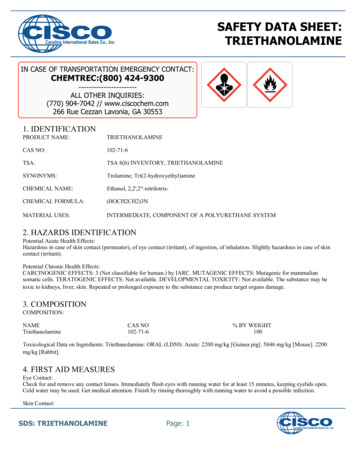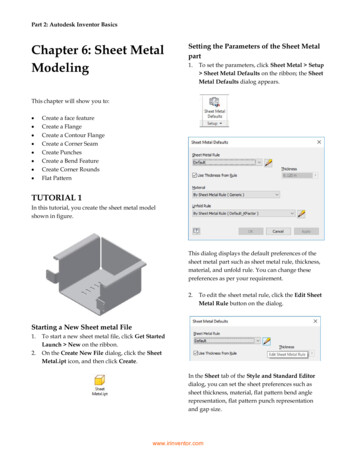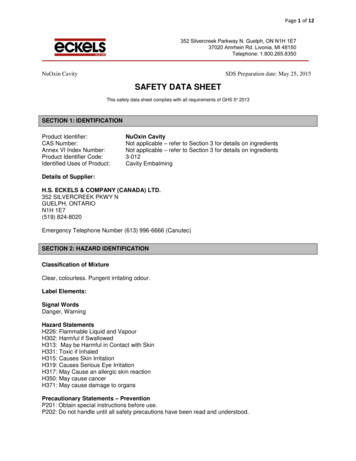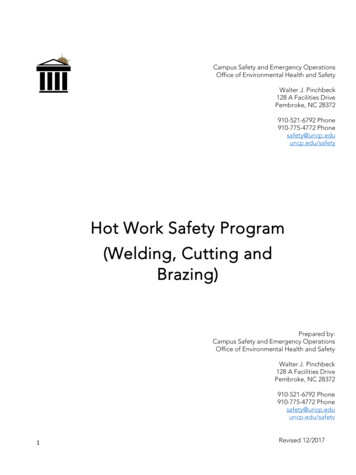
Transcription
SAFETY DATA SHEET:TRIETHANOLAMINEIN CASE OF TRANSPORTATION EMERGENCY CONTACT:CHEMTREC:(800) 424-9300----------------------ALL OTHER INQUIRIES:(770) 904-7042 // www.ciscochem.com266 Rue Cezzan Lavonia, GA 305531. IDENTIFICATIONPRODUCT NAME:TRIETHANOLAMINECAS NO:102-71-6TSA:TSA 8(b) INVENTORY, TRIETHANOLAMINESYNONYMS:Trolamine; Tri(2-hydroxyethyl)amineCHEMICAL NAME:Ethanol, 2,2',2"-nitrilotris-CHEMICAL FORMULA:(HOCH2CH2)3NMATERIAL USES:INTERMEDIATE, COMPONENT OF A POLYURETHANE SYSTEM2. HAZARDS IDENTIFICATIONPotential Acute Health Effects:Hazardous in case of skin contact (permeator), of eye contact (irritant), of ingestion, of inhalation. Slightly hazardous in case of skincontact (irritant).Potential Chronic Health Effects:CARCINOGENIC EFFECTS: 3 (Not classifiable for human.) by IARC. MUTAGENIC EFFECTS: Mutagenic for mammaliansomatic cells. TERATOGENIC EFFECTS: Not available. DEVELOPMENTAL TOXICITY: Not available. The substance may betoxic to kidneys, liver, skin. Repeated or prolonged exposure to the substance can produce target organs damage.3. COMPOSITIONCOMPOSITION:NAMETriethanolamineCAS NO102-71-6% BY WEIGHT100Toxicological Data on Ingredients: Triethanolamine: ORAL (LD50): Acute: 2200 mg/kg [Guinea pig]. 5846 mg/kg [Mouse]. 2200mg/kg [Rabbit].4. FIRST AID MEASURESEye Contact:Check for and remove any contact lenses. Immediately flush eyes with running water for at least 15 minutes, keeping eyelids open.Cold water may be used. Get medical attention. Finish by rinsing thoroughly with running water to avoid a possible infection.Skin Contact:SDS: TRIETHANOLAMINEPage: 1
Wash with soap and water. Cover the irritated skin with an emollient. Get medical attention if irritation develops. Cold water may beused.Serious Skin Contact:Wash with a disinfectant soap and cover the contaminated skin with an anti-bacterial cream. Seek medical attention.Inhalation:If inhaled, remove to fresh air. If not breathing, give artificial respiration. If breathing is difficult, give oxygen. Get medicalattention.Serious Inhalation: Not available.Ingestion:Do NOT induce vomiting unless directed to do so by medical personnel. Never give anything by mouth to an unconscious person.Loosen tight clothing such as a collar, tie, belt or waistband. Get medical attention if symptoms appear.Serious Ingestion: Not available.5. FIRE FIGHTING MEASURESFlammability of the Product: May be combustible at high temperature.Auto-Ignition Temperature: Not available.Flash Points: CLOSED CUP: 179.44 C (355 F). OPEN CUP: 190.5 C (374.9 F) (Cleveland).Flammable Limits: Not available.Products of Combustion: These products are carbon oxides (CO, CO2).Fire Hazards in Presence of Various Substances:Slightly flammable to flammable in presence of open flames and sparks, of heat. Non-flammable in presence of shocks.Explosion Hazards in Presence of Various Substances:Risks of explosion of the product in presence of mechanical impact: Not available. Risks of explosion of the product in presence ofstatic discharge: Not available.Fire Fighting Media and Instructions:SMALL FIRE: Use DRY chemical powder. LARGE FIRE: Use water spray, fog or foam. Do not use water jet.Special Remarks on Fire Hazards: Not available.Special Remarks on Explosion Hazards: Not available.6. ACCIDENTAL RELEASE MEASURESSmall Spill:Dilute with water and mop up, or absorb with an inert dry material and place in an appropriate waste disposal container. If necessary:Neutralize the residue with a dilute solution of acetic acid. Finish cleaning by spreading water on the contaminated surface anddispose of according to local and regional authority requirements.Large Spill:If the product is in its solid form: Use a shovel to put the material into a convenient waste disposal container. If the product is in itsliquid form: Absorb with an inert material and put the spilled material in an appropriate waste disposal. Neutralize the residue with adilute solution of acetic acid. Finish cleaning by spreading water on the contaminated surface and allow to evacuate through thesanitary system. Be careful that the product is not present at a concentration level above TLV. Check TLV on the MSDS and withlocal authorities.Personal precautionsNo action shall be taken involving any personal risk or without suitable training. Evacuate surrounding areas. Keep unnecessary andunprotected personnel from entering. Do not touch or walk through spilled material. Avoid breathing vapor or mist. ProvideSDS: TRIETHANOLAMINEPage: 2
adequate ventilation. Wear appropriate respirator when ventilation is inadequate. Put on appropriate personal protective equipment .7. HANDLING AND STORAGEHandlingPut on appropriate personal protective equipment (see Section 8). Eating, drinking and smoking should be prohibited in areas wherethis material is handled, stored and processed. Workers should wash hands and face before eating, drinking and smoking. Removecontaminated clothing and protective equipment before entering eating areas. Do not ingest. Avoid contact with eyes, skin andclothing. Avoid breathing vapor or mist. Keep in the original container or an approved alternative made from a compatible material,kept tightly closed when not in use. Empty containers retain product residue and can be hazardous. Do not reuse container.StorageStore in accordance with local regulations. Store in original container protected from direct sunlight in a dry, cool and wellventilated area, away from incompatible materials (see section 10) and food and drink. Keep container tightly closed and sealed untilready for use. Containers that have been opened must be carefully resealed and kept upright to prevent leakage. Do not store inunlabeled containers. Use appropriate containment to avoid environmental contamination.Precautions:Keep locked up. Keep away from heat. Keep away from sources of ignition. Empty containers pose a fire risk, evaporate the residueunder a fume hood. Ground all equipment containing material. Do not ingest. Do not breathe gas/fumes/ vapor/ spray. Wear suitableprotective clothing. In case of insufficient ventilation, wear suitable respiratory equipment. If ingested, seek medical adviceimmediately and show the container or the label. Avoid contact with skin and eyes. Keep away from incompatibles such as oxidizingagents, reducing agents, organic materials, metals, acids.8. EXPOSURE CONTROLS AND PERSONAL PROECTIONIngredientTriethanolamineExposure limitsACGIH TLV (United States, 2/2010).TWA: 5 mg/m3 8 hour(s).Recommended monitoring proceduresIf this product contains ingredients with exposure limits, personal, workplace atmosphere or biological monitoring may be requiredto determine the effectiveness of the ventilation or other control measures and/or the necessity to use respiratory protectiveequipment.Engineering Controls:Provide exhaust ventilation or other engineering controls to keep the airborne concentrations of vapors below their respectivethreshold limit value. Ensure that eyewash stations and safety showers are proximal to the work-station location.Personal Protection:Splash goggles. Lab coat. Vapor respirator. Be sure to use an approved/certified respirator or equivalent. Gloves.Personal Protection in Case of a Large Spill:Splash goggles. Full suit. Vapor respirator. Boots. Gloves. A self contained breathing apparatus should be used to avoid inhalation ofthe product. Suggested protective clothing might not be sufficient; consult a specialist BEFORE handling this product.Exposure Limits:TWA: 5 from ACGIH (TLV) [United States] [2001] Consult local authorities for acceptable exposure limits.Personal protectionRespiratoryRecommended: Respiratory protection, filter A In case of inadequate ventilation wear respiratory protection. Respirator selectionmust be based on known or anticipated exposure levels, the hazards of the product and the safe working limits of the selectedrespirator.HandsSDS: TRIETHANOLAMINEPage: 3
Chemical-resistant, impervious gloves complying with an approved standard should be worn at all times when handling chemicalproducts if a risk assessment indicates this is necessary. 8 hours (breakthrough time): butyl rubber, nitrile rubberEyesSafety eyewear complying with an approved standard should be used when a risk assessment indicates this is necessary to avoidexposure to liquid splashes, mists or dusts.SkinPersonal protective equipment for the body should be selected based on the task being performed and the risks involved and shouldbe approved by a specialist before handling this product.Environmental exposure controlsEmissions from ventilation or work process equipment should be checked to ensure they comply with the requirements ofenvironmental protection legislation. In some cases, fume scrubbers, filters or engineering modifications to the process equipmentwill be necessary to reduce emissions to acceptable levels.9. PHYSICAL AND CHEMICAL PROPERTIESPhysical state and appearance: Liquid. (Clear viscous liquid.)Odor: Ammoniacal. (Slight.)Taste: Not available.Molecular Weight: 149.19 g/moleColor: Colorless to light yellow.pH (1% soln/water): 10 [Basic.]Boiling Point: 335 C (635 F)Melting Point: 21.5 C (70.7 F)Critical Temperature: Not available.Specific Gravity: 1.12 (Water 1)Vapor Pressure: 0 kPa (@ 20 C)Vapor Density: 5.1(Air 1)Volatility: Not available.Odor Threshold: Not available.Water/Oil Dist. Coeff.: The product is more soluble in water; log(oil/water) -1Ionicity (in Water): Not available.Dispersion Properties: See solubility in water, methanol, acetone.Solubility:Easily soluble in cold water, hot water. Soluble in methanol, acetone. Very slightly soluble in diethyl ether, n-octanol.10. STABILITY AND REACTIVITYStability: The product is stable.Instability Temperature: Not available.SDS: TRIETHANOLAMINEPage: 4
Conditions of Instability: Excess heat, light, exposure to air, exposure to moist air or water, incompatible materialsIncompatibility with various substances:Highly reactive with oxidizing agents, acids. Reactive with reducing agents, organic materials, metals. Slightly reactive to reactivewith moisture.Corrosivity:Corrosive in presence of steel, of aluminum, of zinc, of copper. Non-corrosive in presence of glass.Special Remarks on Reactivity:Very hygroscopic. Turns brown on exposure to air and light.Special Remarks on Corrosivity: Not available.Polymerization: Will not occur.11. TOXICOLOGICAL INFORMATIONRoutes of Entry: Absorbed through skin. Dermal contact. Eye contact.Toxicity to Animals: Acute oral toxicity (LD50): 2200 mg/kg [Rabbit].Chronic Effects on Humans:CARCINOGENIC EFFECTS: 3 (Not classifiable for human.) by IARC. MUTAGENIC EFFECTS: Mutagenic for mammaliansomatic cells. May cause damage to the following organs: kidneys, liver, skin.Other Toxic Effects on Humans:Hazardous in case of skin contact (permeator), of ingestion, of inhalation. Slightly hazardous in case of skin contact (irritant).Special Remarks on Toxicity to Animals:LD50 [Rat] - Route: Oral; Dose: 4920 ul/kg LD50 [Rabbit] - Route: Skin; Dose: 20ml/kgSpecial Remarks on Chronic Effects on Humans:May cause cancer (tumorigenic) based on animal data. May affect genetic material (mutagen): cytogenic analysis (humanlymphocyte) 100 umol/L; sister chromatid exchange (human lymphocyte) 1mmol/L.Special Remarks on other Toxic Effects on Humans:Acute Potential Health Effects: Skin: May cause skin irritaiton with burning pain, itching, and redness. May be absorbed through theskin amd affect the liver, metabolism, and urinary tract. Eyes: Causes eye irritation with tearing and burning pain. May causetransient corneal injury. Ingestion: Causes gastrointestinal (digestive) tract irritation with nausea, vomitig, and diarrhea. May alsoaffect behavior, sense organs, liver and urinary system. Inhalation: Inhalation of mist may cause respiratory tract irritation. May alsoaffect the liver, blood, urinary system and cardiovascular system. Chronic Potential Health Effects: May cause liver and kidneydamage. Prolonged or repeated contact may cause skin necrosis and /or ulceration of the skin.12. ECOLOGICAL INFORMATIONEcotoxicity: Not available.BOD5 and COD: Not available.Products of Biodegradation:Possibly hazardous short term degradation products are not likely. However, long term degradation products may arise.Toxicity of the Products of Biodegradation: The product itself and its products of degradation are not toxic.Special Remarks on the Products of Biodegradation: Not available.13. DISPOSAL CONSIDERATIONSWaste Disposal:Waste must be disposed of in accordance with federal, state and local environmental control regulations.SDS: TRIETHANOLAMINEPage: 5
The generation of waste should be avoided or minimized wherever possible. Significantquantities of waste product residues should not be disposed of via the foul sewer but processed in a suitable effluent treatment plant.Dispose of surplus and non-recyclable products via a licensed waste disposal contractor. Disposal of this product, solutions and anyby-products should at all times comply with the requirements of environmental protection and waste disposal legislation and anyregional local authority requirements. Waste packaging should be recycled. Incineration or landfill should only be considered whenrecycling is not feasible. This material and its container must be disposed of in a safe way. Care should be taken when handlingemptied containers that have not been cleaned or rinsed out. Empty containers or liners may retain some product residues. Avoiddispersal of spilled material and runoff and contact with soil, waterways, drains and sewers.14. TRANSPORT INFORMATIONDOT Classification: Not a DOT controlled material (United States).Identification: Not applicable.Special Provisions for Transport: Not applicable.15. REGULATORY INFORMATIONFederal and State Regulations:Rhode Island RTK hazardous substances: Triethanolamine Pennsylvania RTK: Triethanolamine Minnesota: TriethanolamineMassachusetts RTK: Triethanolamine TSCA 8(b) inventory: Triethanolamine TSCA 8(d) H and S data reporting: TriethanolamineOther Regulations:OSHA: Hazardous by definition of Hazard Communication Standard (29 CFR 1910.1200). EINECS: This product is on theEuropean Inventory of Existing Commercial Chemical Substances.Other Classifications:WHMIS (Canada): Not controlled under WHMIS (Canada).DSCL (EEC):R36- Irritating to eyes. R40- Possible risks of irreversible effects. S2- Keep out of the reach of children. S36/37- Wear suitableprotective clothing and gloves. S46- If swallowed, seek medical advice immediately and show this container or label.HMIS (U.S.A.):Health Hazard: 2Fire Hazard: 1 Reactivity: 1Personal Protection: hNational Fire Protection Association (U.S.A.): Health: 2Flammability: 1Reactivity: 1Specific hazard:Protective Equipment:Gloves. Lab coat. Vapor respirator. Be sure to use an approved/certified respirator or equivalent. Splash goggles.16. OTHER INFORMATIONLABEL REQUIREMENTS:MAY CAUSE EYE AND SKIN IRRITATION. CONTAINS MATERIAL THAT MAY CAUSE TARGET ORGAN DAMAGE,BASED ON ANIMAL DATA.HEALTH:FLAMMABILITY:PHYSICAL HAZARDS:110Notice to readerWhile the information and recommendations in this publication are to the best of our knowledge, information and belief accurate atthe date of publication, NOTHING HEREIN IS TO BE CONSTRUED AS A WARRANTY, EXPRESS OR OTHERWISE.IN ALL CASES, IT IS THE RESPONSIBILITY OF THE USER TO DETERMINE THE APPLICABILITY OF SUCHSDS: TRIETHANOLAMINEPage: 6
INFORMATION AND RECOMMENDATIONS AND THE SUITABILITY OF ANY PRODUCT FOR ITS OWN PARTICULARPURPOSE.THE PRODUCT MAY PRESENT HAZARDS AND SHOULD BE USED WITH CAUTION. WHILE CERTAIN HAZARDS AREDESCRIBED IN THIS PUBLICATION, NO GUARANTEE IS MADE THAT THESE ARE THE ONLY HAZARDS THATEXIST .Hazards, toxicity and behavior of the products may differ when used with other materials and are dependent upon the manufacturingcircumstances or other processes. Such hazards, toxicity and behavior should be determined by the user and made known tohandlers, processors and end users.Date Created: 6/5/2015Date Updated: 6/5/2015SDS: TRIETHANOLAMINEPage: 7
Water/Oil Dist. Coeff.: The product is more soluble in water; log(oil/water) -1 Ionicity (in Water): Not available. Dispersion Properties: See solubility in water, methanol, acetone. Solubility: Easily soluble in cold water, hot water. Soluble in methanol, acetone. Very slightly soluble in diethyl ether, n-octanol. 10. STABILITY AND REACTIVITY










